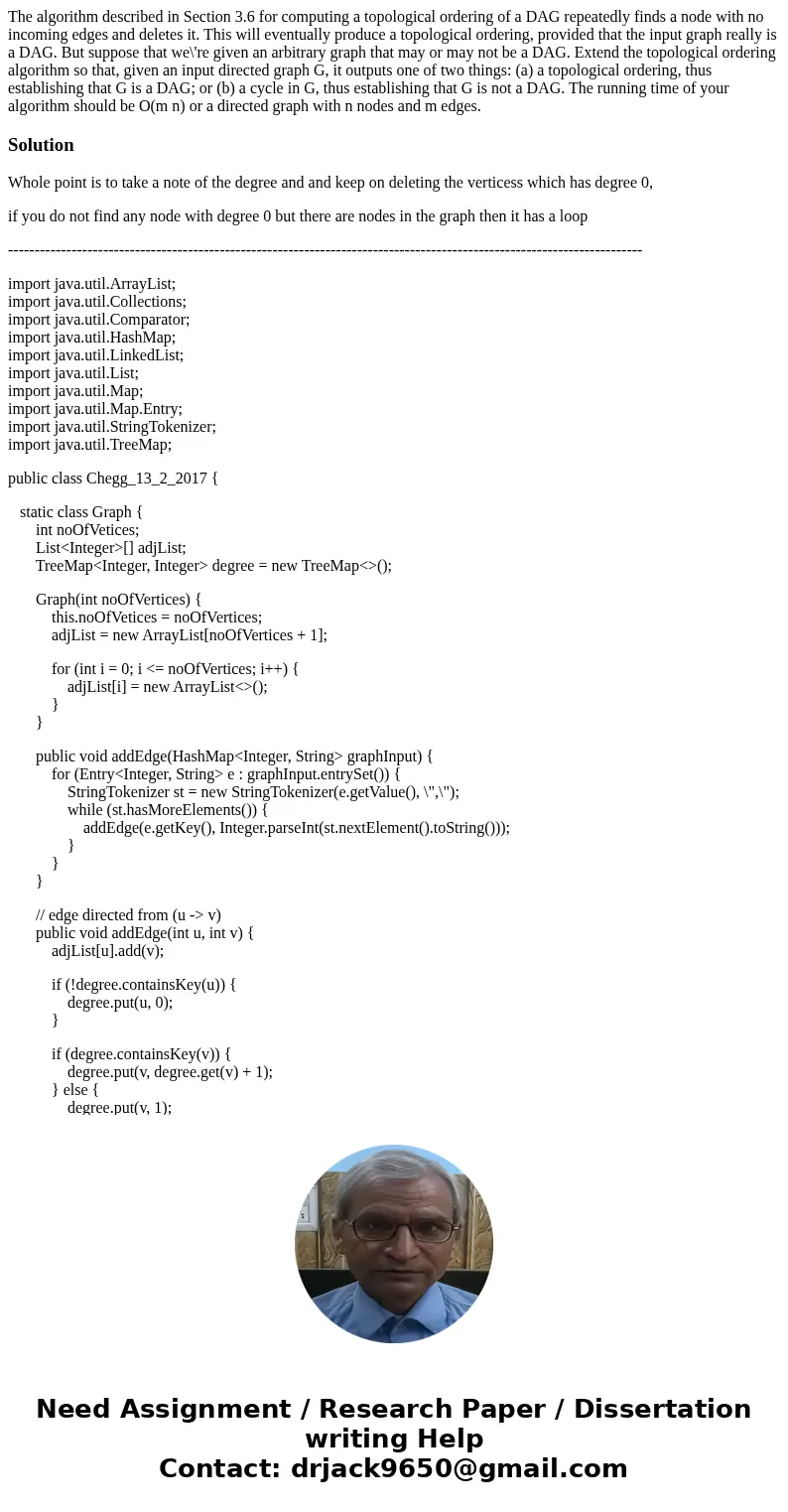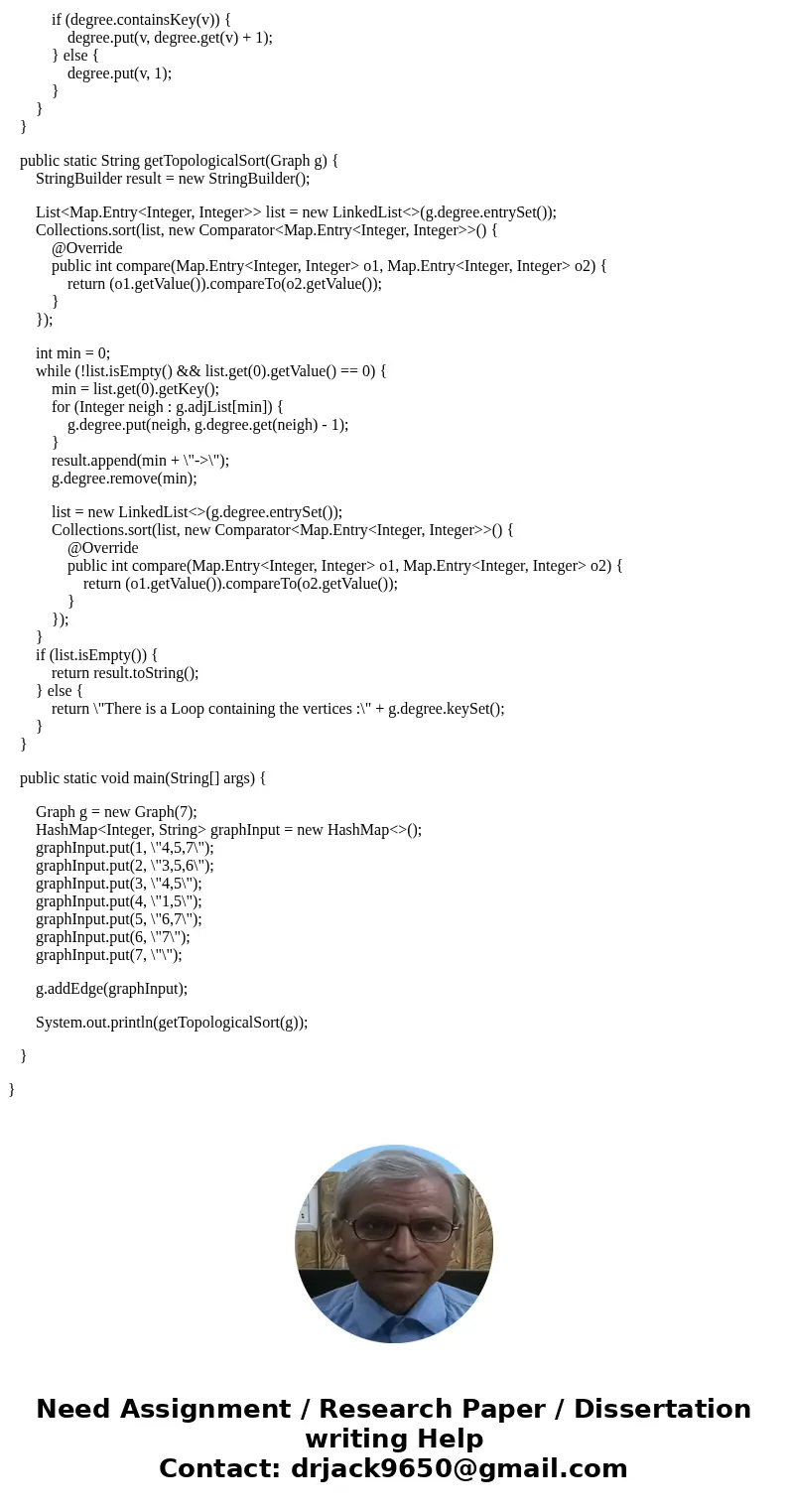The algorithm described in Section 36 for computing a topolo
Solution
Whole point is to take a note of the degree and and keep on deleting the verticess which has degree 0,
if you do not find any node with degree 0 but there are nodes in the graph then it has a loop
------------------------------------------------------------------------------------------------------------------------
import java.util.ArrayList;
import java.util.Collections;
import java.util.Comparator;
import java.util.HashMap;
import java.util.LinkedList;
import java.util.List;
import java.util.Map;
import java.util.Map.Entry;
import java.util.StringTokenizer;
import java.util.TreeMap;
public class Chegg_13_2_2017 {
static class Graph {
int noOfVetices;
List<Integer>[] adjList;
TreeMap<Integer, Integer> degree = new TreeMap<>();
Graph(int noOfVertices) {
this.noOfVetices = noOfVertices;
adjList = new ArrayList[noOfVertices + 1];
for (int i = 0; i <= noOfVertices; i++) {
adjList[i] = new ArrayList<>();
}
}
public void addEdge(HashMap<Integer, String> graphInput) {
for (Entry<Integer, String> e : graphInput.entrySet()) {
StringTokenizer st = new StringTokenizer(e.getValue(), \",\");
while (st.hasMoreElements()) {
addEdge(e.getKey(), Integer.parseInt(st.nextElement().toString()));
}
}
}
// edge directed from (u -> v)
public void addEdge(int u, int v) {
adjList[u].add(v);
if (!degree.containsKey(u)) {
degree.put(u, 0);
}
if (degree.containsKey(v)) {
degree.put(v, degree.get(v) + 1);
} else {
degree.put(v, 1);
}
}
}
public static String getTopologicalSort(Graph g) {
StringBuilder result = new StringBuilder();
List<Map.Entry<Integer, Integer>> list = new LinkedList<>(g.degree.entrySet());
Collections.sort(list, new Comparator<Map.Entry<Integer, Integer>>() {
@Override
public int compare(Map.Entry<Integer, Integer> o1, Map.Entry<Integer, Integer> o2) {
return (o1.getValue()).compareTo(o2.getValue());
}
});
int min = 0;
while (!list.isEmpty() && list.get(0).getValue() == 0) {
min = list.get(0).getKey();
for (Integer neigh : g.adjList[min]) {
g.degree.put(neigh, g.degree.get(neigh) - 1);
}
result.append(min + \"->\");
g.degree.remove(min);
list = new LinkedList<>(g.degree.entrySet());
Collections.sort(list, new Comparator<Map.Entry<Integer, Integer>>() {
@Override
public int compare(Map.Entry<Integer, Integer> o1, Map.Entry<Integer, Integer> o2) {
return (o1.getValue()).compareTo(o2.getValue());
}
});
}
if (list.isEmpty()) {
return result.toString();
} else {
return \"There is a Loop containing the vertices :\" + g.degree.keySet();
}
}
public static void main(String[] args) {
Graph g = new Graph(7);
HashMap<Integer, String> graphInput = new HashMap<>();
graphInput.put(1, \"4,5,7\");
graphInput.put(2, \"3,5,6\");
graphInput.put(3, \"4,5\");
graphInput.put(4, \"1,5\");
graphInput.put(5, \"6,7\");
graphInput.put(6, \"7\");
graphInput.put(7, \"\");
g.addEdge(graphInput);
System.out.println(getTopologicalSort(g));
}
}


 Homework Sourse
Homework Sourse